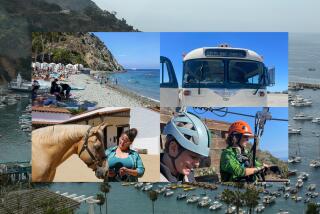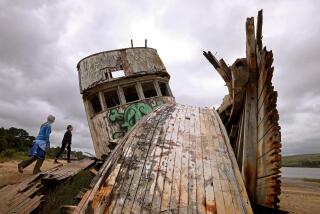BEEKS, BALBOA BOATS HAVE BEEN AROUND FOR 70 YEARS : Ferry Tales
In a county where locals call themselves grizzled pioneers if their residency predates Disneyland, the Beek family is something of a marvel. Members have been running the same business, in the same place, every day for nearly 70 years.
In Orange County, that’s tantamount to being a witness to the War of the Roses, but if there is such a thing as a self-perpetuating institution, the Beeks have it.
They run the Balboa Island Ferry, and have since 1919. That may not be a record for longevity in business, but it certainly shows that the family knows how to hold a job.
“I have a very fond feeling” for the ferry, said Seymour Beek, the president of the corporation that operates it. “It was an adjunct to my life and I’ve always taken pride in it. We always enjoyed operating it and now it’s sort of a community institution. And now, of course, it’s unique because there are hardly any ferryboats in California at all.”
To residents of Balboa Island and Balboa Peninsula, there has always been a ferry, for a boat has made the crossing between the two points since the days when both the island and the peninsula were nothing more than nondescript sand spits. And, not coincidentally, there has nearly always been a Beek living on the island, for if there was one man who can be said to have had the most influence on the development of Balboa Island, it was Seymour’s father, Joe Beek.
When Joe Beek rode for the first time to Newport Beach on the Pacific Electric line for a picnic in 1907, there was no ferry to take him to the soggy mud flat that was Balboa Island. An electrical engineering student at Throop Polytechnic Institute in Pasadena (now Caltech), Beek saw an opportunity to develop the island with vacation homes. Two years later, after Beek had begun his development venture, the first ferry service began when W.S. Collins was awarded a city permit.
The first ferry had almost as puny a beginning as the island development. The vessel was nothing more than a rowboat with a tiny outboard engine. Called the Teal, it was captained by a large, rough-hewn man named John Watts, who sang spirituals as he made his crossings.
Other operators took over from Collins during the next 10 years, none of them providing satisfactory service, at least in the opinion of the little island community. In 1915, all 26 residents of the island traveled by boat to a meeting of the Newport Beach city trustees and demanded that an islander be made responsible for ferry operations. Joe Beek, who had become the secretary of the state Senate two years before, was awarded the contract and given a $50-per-month subsidy by the city.
Beek’s first small boat, called the Ark, carried only a handful of passengers, but the previous fare of a dime was reduced to a nickel. The Ark was followed by the Islander, which was not much more than the Ark with a top. In 1920, the 22-foot Fat Fairy began making the crossing, pushing an auto barge. The 32-foot Joker appeared in 1922. It could carry two cars and was fitted with propellers and rudders at each end to enable the boat to travel back and forth without turning around.
A one-car ferry, the Square Deal, was launched in 1924, but it was the 56-foot Commodore, which began service in 1930, that foreshadowed the boats in use today. The Commodore could carry three cars and 100 passengers.
The three 64-foot boats that make the crossing from Agate Avenue on the island and Palm Street on the peninsula today--the Admiral, the Commodore and the Captain--were built in the mid-1950s by islander Evan Jones, who worked for Joe Beek from the early 1930s until his retirement in 1968 (Jones’ grandson is a ferry pilot today.). The boats have been pummelled by heavy weather, rammed by errant yachts, missed by drunken motorists, have served as background for an Abbott and Costello movie, and have even hosted a handful of weddings.
“They’re good boats,” Seymour Beek said. “They were built after we had a lot of ferry boat experience. They’ve endured a lot over the years.”
But if the boats are durable, the Beek family is nearly ironclad. As Balboa Island and nearby areas began to grow and develop, Joe Beek became a kind of neighborhood patriarch. He became the commodore of the Newport Harbor Yacht Club and was appointed the city’s first harbor master. He directed the Festival of Lights boat parade from 1921 to 1929. He continued to develop the Beacon Bay neighborhood of Newport Beach, as well as properties in Sacramento. He continued as secretary of the state Senate for more than 50 years. He died in 1968.
Beek’s wife, Carroll, who died in 1981, became active in nearly 20 community organizations and was best known as an ardent environmentalist and government watchdog. She may be best remembered, however, for founding the Balboa Island Yacht Club, a small-boat sailing club specifically for children, which continues to meet regularly in front of the Beek home on the island across the bay from the Balboa Pavilion.
The Beeks had three sons: Seymour, 54, a program manager at Ford Aerospace in Newport Beach; Allan, 61, a guidance computer designer for Rockwell International in Anaheim, and Barton, 64, a Los Angeles attorney. All of them grew up on the island and worked on the ferry during their school years. Today, they make up the board of directors for the ferry corporation (the actual operation of the business is left to a small permanent staff).
But it is Seymour Beek who remains closest to the operation. Several years ago, he and his family moved back into the family home on Bay Front, only a few steps from the island ferry landing.
“When I was growing up,” he said, “this was a much smaller community, and the ferry was a small business along with other small businesses. Today, it’s sort of taking on the stature of an institution. It has historical value and people look on it nostalgically. But in the old days, there were really only tourists in the summer, so there wasn’t that much year-round business. (The area) was nearly deserted in the off-season, like a small town. During most of the year, there was just one guy out there working on one ferry boat. Today, you get sightseers and people out for a good time all year. We get busy anytime there’s a nice day.”
Growing up in the ferry business at a summer resort paid dividends, said Allan Beek, who lives in Newport Beach.
“I was spoiled rotten,” he said. “Can you imagine anyplace better to grow up than the south bay front of Balboa Island? We felt a little bit slighted because there were no trees to climb, but we had the beach and the sand bars to play on. And we got to ride the ferry for free.”
He took the ferry each day to Newport Beach Grammar School on the peninsula when he was a child and collected fares on the ferry during his teens, which, he said, didn’t hurt his stature with visiting girls.
“You really wore your eyes out in the summer working out there,” he said.
Barton Beek, who lives in Pasadena, became a licensed ferry pilot during his school years.
“Nobody insisted I do it,” he said, “but I just assumed I’d be able to work on the ferry in the summertime. I remember hauling a lot of service people back and forth during the war years. A lot of big bands like Bob Crosby would come down to the Rendezvous Ballroom and I remember carrying some of the musicians who had girlfriends on the island. Those musicians were some pretty famous names in their time.”
Some lesser names have crept--actually, crashed--into ferry lore over the years, Seymour said. With the ferry carrying 2.5 million passengers a year, and each boat making an average of seven round trips each hour, someone is bound to make a misstep.
“In the early days, when I was a kid, somebody drove a milk truck into the slip on the peninsula about 4 a.m. and there was no boat there,” Barton recalled. “The guy who drove it in just walked away and didn’t say anything for a while, and the next day the ferry hit the truck.”
About 25 years ago, Seymour said, a telephone company truck made the same error on the island side. “And it floated,” he said. “It was a van and it actually floated. It just got towed over to the beach and a tow truck came and picked it up.”
In the late 1970s, Seymour said, a motorcyclist “just did an Evel Knievel off the ramp. Just came roaring down and sailed right into the bay.”
And, six or seven years ago, a group of students pulled a stunt that Seymour remembers with fondness.
“Two guys wheeled this third guy on board in a wheelchair and halfway across the bay they got into this noisy argument,” he said. “And these guys picked up the one in the chair and threw him into the bay. The people on the ferry were horrified . It was a marvelous stunt.”
The ferry has run nearly continuously throughout its history, but Seymour said that in 1983, during a period of fierce stormy weather, operations had to be “shut down for a few hours. We’ve almost never had to stop operating, but that storm was really bad. The waves in the bay were actually coming up over the decks of the ferry boats. It was pretty scary and getting them into the docks got hazardous.”
The boats occasionally are chartered for private party cruises around the bay, and have also been used as camera platforms by a handful of movie companies. Weddings have been performed on board and the boats have appeared in ads for cars and lines of clothing.
It hasn’t always been so benign. During the notorious Bal Week celebrations of the 1950s and early ‘60s, some ferry crews carried clubs as a deterrent to fights. And during one unruly crossing, one crew was forced to turn water hoses on a group of rowdy passengers.
“But,” Seymour said, “for the most part the ferry goes on and on, and in most of its life it’s pretty routine.”
The ferry makes a profit, Seymour said, but he declined to say how much. Still, figuring that 2.5 million passengers cross each year, at an average fare of 45 cents (cars with drivers and no passengers are charged 55 cents, pedestrians 20 cents), the ferry brings in more than $1.1 million each year. A percentage of the gross, Seymour said, is paid to the city for the use of the street ends on the island and the peninsula for the docks.
Seymour Beek still drops in to the ferry office next to the island dock “several days a week.” The building is hard to miss. Above the door, in large letters, is the name of the patriarch of the clan and, indirectly, the island itself: J.A. Beek.
“I like being a part of it,” said Seymour Beek. “I get kidded about the ferry business and it’s a great source of conversation.”
“But,” he said with a small smile, “when I get on the ferry and drop my name, they charge me double.”
More to Read
Sign up for The Wild
We’ll help you find the best places to hike, bike and run, as well as the perfect silent spots for meditation and yoga.
You may occasionally receive promotional content from the Los Angeles Times.






